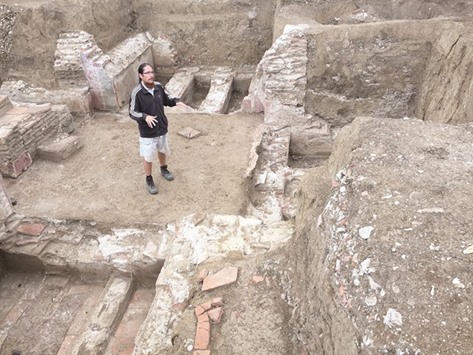A large Roman-era necropolis in eastern Serbia has yielded a spectacular find for archaeologists: gold and silver foils asking favours of deities and demons via deceased couriers.
These rare amulets were found in early August in a freshly exposed family tomb at Viminacium, a first-century Roman outpost near a power plant at the small town of Kostolac.
Experts are still trying to understand the messages etched on the small plates, says Miomir Korac, the chief archaeologist.
“Dobrebao. Seneseilam. Sesengemfaranges. We don’t recognise these magic words, written in Aramaic using the Greek alphabet,” he says. “For all we know, they may have tried to turn stone into gold.”
“We’re trying, but we may never decipher it.”
Messages like these are not rare phenomenon in Viminacium or elsewhere, but are typically found written on lead leaflets, whereas gold and silver were not often used and are found extremely rarely.
“Appeals to otherworldly forces, called katedesmos in Greek and defixiones in Roman, were common. But today we almost exclusively find amulets made of lead,” archaeologist Ilija Dankovic says.
They carried spells, written on tablets roughly half the size of a post-it note, then scrolled and sealed within lead capsules.
The amulets were buried in soil or thrown into a river, but also slipped into graves so that the deceased could hand the note to the right deity or demon on the other side.
It was believed that children and murder victims were best messengers, their souls supposedly taking longer before finding find rest and with more time to deliver, Dankovic said.
A golden amulet with Greek lettering was found alongside a child’s remains in a recently exposed family tomb holding 11 bodies, while another, with a still unexamined silver and gold leaflets, was buried alongside a young woman.
The content of the Viminacium amulets still baffles experts, but previously uncovered tablets carried a wide range of wishes, from the good, to the very evil.
“‘Make this man love me’ or ‘make his body as heavy and dead as this lead’ were as common as appeals to some force for luck with their bets on chariot races,” Dankovic said.
Roman authorities occasionally banned the spells, worrying that they were dangerous.
Viminacium, 60 kilometres east of Belgrade, was a military outpost started in 1st century, though the area had been settled millennia before, as neolithic artefacts indicate.
A military place, laid out for functionality, the garrison and the town that sprang up alongside it were the site of many graves for over 17 centuries, providing great insight into the life of soldiery and civilians of the era.
Particularly precious is the largest-known necropolis from the Roman era, Korac added.
“So far we explored 14,000 graves. That’s the largest number of Roman Empire graves ever explored and we estimate that there are another 10,000 still under the soil,” he explained.
In the early days, unearthed graves were emptied, artefacts stored and the bones perfunctorily examined to determine the sex and age of the deceased.
At Viminacium today, there are around 30 experts, from archaeologists to palaeographers to physical anthropologists, all puzzling together a picture of the past.
“Science advances quickly and now we plan to set up a DNA laboratory and learn ever more from the remains, cremated and buried, as we can,” Korac said. —DPA

THE LOCATION: Archaeologist Ilija Dankovic shows the family tomb where the magic amulets were found in the necropolis of the Roman-era Viminacium garrison, near Kostolac in eastern Serbia.

